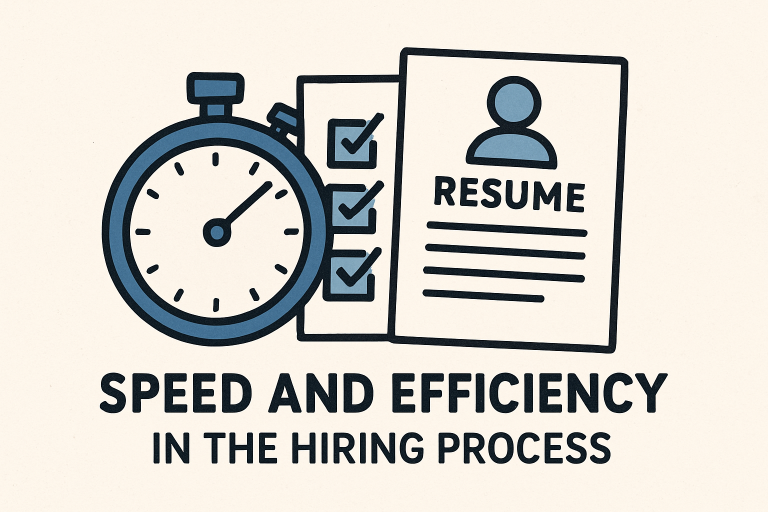Table of Contents
Introduction
In today’s rapidly evolving business world, the speed of your hiring process directly shapes your team’s productivity, cohesion, and ability to achieve strategic objectives. A key metric in recruitment efficiency, time-to-hire, measures how swiftly organizations move from identifying staffing needs to onboarding new talent. Companies prioritizing this metric gain a measurable edge, minimizing lost productivity and maintaining project momentum.
Fast, streamlined hiring not only ensures critical roles are filled promptly but also strengthens employer reputation, attracting candidates eager to work for nimble, organized businesses. When hiring lags, projects slow, and teams experience stress from increased workloads, further highlighting the importance of optimizing the time-to-hire.
A modern, efficient recruitment process goes beyond filling jobs quickly. It enhances the candidate journey, creating a competitive talent marketplace advantage. Streamlined procedures demonstrate respect for applicants’ time while signaling an attentive, dynamic culture. This can be decisive for high-caliber candidates weighing several job offers.
Furthermore, adopting technology and structured methodologies helps you future-proof your hiring strategy. As the labor market tightens and candidate expectations rise, the organizations that excel will be those that continuously invest in rapid, high-quality hiring processes.
Reduced Time-to-Hire
Accelerating the hiring process reduces time spent with roles unfilled and projects delayed. By proactively preparing job descriptions and interview frameworks, teams can act decisively when a vacancy arises. This swiftness is critical—extended job vacancies can disrupt workflows, place extra burdens on current employees, and damage overall morale. Reducing the time-to-hire ensures uninterrupted business operations and empowers teams to capitalize on new opportunities as they arise.
Improved Candidate Experience
A streamlined, transparent hiring journey often leaves a lasting impression on candidates, even if they aren’t ultimately selected. Consistent, prompt communication, clear expectations, and effective interview scheduling foster trust and goodwill. An efficient process can set an organization apart, with employer reputation now influencing where top talent chooses to apply. Research from Harvard Business Review highlights that organizations offering fast decisions and clear feedback build stronger relationships with future hires.

Cost Savings
The longer a position remains open, the higher the hidden costs are, including lost productivity and additional burden on existing staff. Prolonged interview cycles also add administrative expenses and increase the likelihood of missing out on qualified candidates. By refining hiring processes and eliminating inefficient steps, companies save not only money but also preserve organizational energy, channeling attention back to growth and innovation.
Enhanced Quality of Hire
Streamlining isn’t about cutting corners but upgrading evaluation processes so the right candidates are identified and engaged quickly. Structured screening tools, standardized assessments, and skills-based interviews contribute to a higher hiring quality. This results in stronger team fit and lower turnover, as new employees are set up for success from the outset. According to Forbes, consistency in recruiting also helps remove bias and ensures every hire meets the organization’s standards.
Case Studies
Organizations across industries have harnessed the power of streamlined hiring:
- General Motors (GM): GM’s investment in automating recruitment steps, including interview scheduling, cut the interview timeline from up to a week to just 16 minutes. This innovation supports GM’s larger goal: reducing hourly worker hiring time from 60 days to as little as 60 minutes.
- LinkedIn’s Product Team: By re-engineering their process, LinkedIn cut the average hiring time from 83 to 41 days. This transformation accelerated hiring and elevated the candidate experience throughout every stage.
Implementing AI and Automation
Intelligent recruitment technologies, such as AI-powered applicant tracking systems, can automate repetitive tasks such as screening resumes, shortlisting candidates, and scheduling interviews. Automation minimizes human error, broadens talent pools by analyzing profiles objectively, and frees recruiters to focus on relationship-building and complex decision-making. As reported by SHRM, AI tools are enabling businesses to speed up hiring and improve their effectiveness by matching candidates’ skills to specific job requirements faster than traditional methods.
Best Practices for Streamlining Hiring
Continual improvement is key to maintaining an efficient hiring process. Consider these fundamental strategies:
- Define Clear Job Descriptions: Precise criteria help attract qualified candidates and reduce mismatches.
- Utilize Technology: Leverage applicant tracking systems and automation tools to limit manual entry and repetitive tasks.
- Standardize Interviews: Consistent evaluation gives each applicant a fair chance and streamlines comparison.
- Train Hiring Teams: Alignment ensures all team members understand the process and your company’s values.
- Monitor and Adapt: Regularly measure hiring process metrics to identify bottlenecks and areas for improvement. Adjust workflows in response to feedback and performance data.
Refining hiring methods is an ongoing journey. By following these best practices, organizations create hiring processes that are fast, effective, and attractive to candidates, supporting business growth and strengthening team cohesion.


